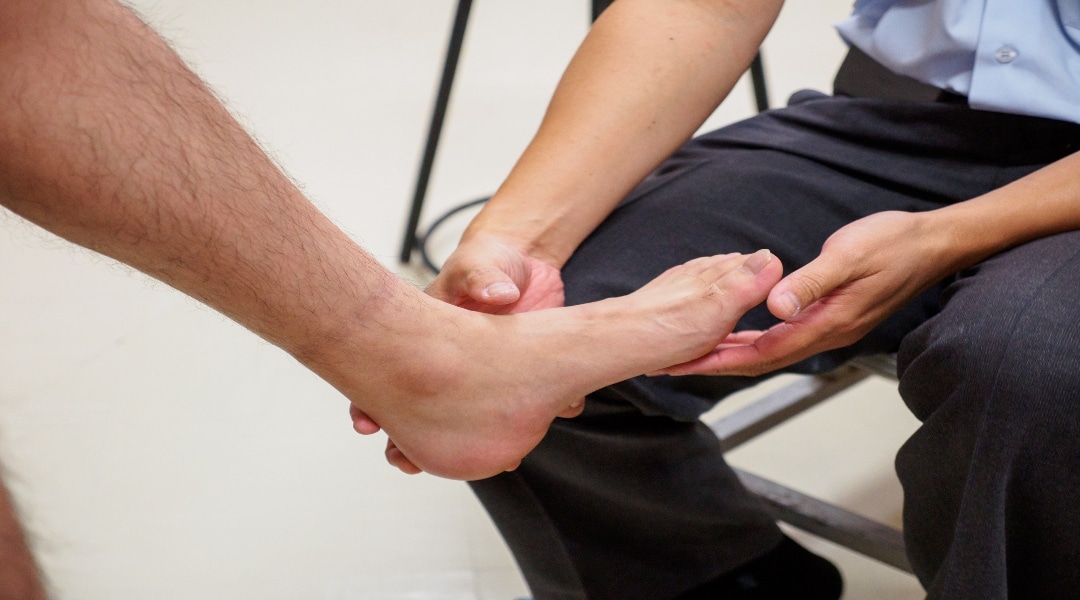Why You Have Arch Pain [and How to Avoid It]
If you constantly struggle with this issue, finding out the cause is the key to managing or eradicating your pain effectively. We get to the root of arch pain, so please don’t hesitate to schedule an appointment with us and get the relief you need!
Causes of Arch Pain – And How We Treat Them
The arch of your foot is not just made up of one muscle, bone, ligament, or tendon. The arch that connects the heel and ball of your foot is actually composed of several small components.
When any of these components becomes inflamed or injured, pain results – and that can occur in a variety of ways. Finding the source is the first step toward curing the ailment. Here are a few common causes.
Flat Feet
Normally, the foot has a sustained curve through the midfoot. But when you have flat feet (aka fallen arches), that curve is compromised.
The rounded shape of your arch is usually supported by tendons that attach to bones in the ball and heel of your foot. When these tendons are not tight enough to support the normal shape of the arch, it tends to flatten.
People may be born with naturally flat feet; their arches just never develop properly.
Other times, flat feet can develop from an injury to the tendons in your heels – especially the posterior tibial tendon that extends from the lower leg down through the ankle and into the heel. Arthritis and nerve damage can also contribute to progressively flatter feet.
Not only can people with flat feet experience tired, aching arches after standing for long periods of time, but they may also find it difficult to stand on their toes. Swelling around the arch is also common.
We have plenty of experience diagnosing and treating flat feet. Typical forms of treatment include:
- Custom orthotic inserts to provide cushioning and corrective support.
- Stretching and conditioning exercises.
- Steroids to reduce inflammation.
- Changes to footwear and activities to reduce stress on your tendons.
Conservative treatments will most often be effective. Only in rare cases might surgery be recommended to find lasting relief.
Overpronation
Overpronation is an abnormality in your gait (the way you walk) that can lead to arch pain.
A foot pronates when it strikes the ground, rolling inward somewhat to help absorb the shock of impact and disperse kinetic energy.
With overpronation, the foot strikes the ground normally on the outer edge of the hell, but then rolls too far inward. This places undue stress on the interior arch.
These forces accumulate with every step, so overpronation in activities like running, where you strike the ground frequently and with great force, can quickly lead to arch pain.
Overpronation can also have more than one cause, so we very much recommend coming to us for the specified help you need. Trying to compensate for overpronation with off-the shelf shoe inserts or other methods may not effectively solve the problem.
For example, sometimes overpronation is caused by a lack of flexibility in the ankle. If it does not bend backward easily enough, your foot will be forced to pronate more to make up the difference and allow your knee to move through a normal walk cycle.
Only addressing the specific cause of overpronation – whether through custom orthotics or other methods – will address the problem as a whole.
Plantar Fasciitis
Plantar Fasciitis is by far the most common type of heel and arch pain. It occurs when the plantar fascia, a band of thick tissue that runs through the arch to connect to your toes, becomes inflamed.
Plantar fasciitis can develop slowly, with only mild heel pain in the morning or when you start moving again after sitting for a while. But as the inflammation increases, the pain can become worse and longer lasting – up to several hours.
Plantar fasciitis is most likely to afflict those who:
- Participate in sports. Those who engage in high-impact exercise but don’t spend enough time warming up the feet and lower legs are more likely to develop plantar fasciitis.
- Are overweight or pregnant. Extra weight places greater stress on the plantar fascia.
- Wear high heels. Heels place your feet in a continual state of stress, as weight is forced toward the front of the foot. The higher the heel, the greater the risk.
- Stand all day. Teachers, nurses, construction workers and other professionals that spend extensive time on their feet each day have increased chances of arch pain.
Fortunately, plantar fasciitis is often simple to treat once the cause of it is identified. Treatments can be similar to those for flat feet, and may include:
- Rest, icing, and elevation.
- Stretching and conditioning exercises.
- Changes to footwear and activity levels.
- Use of custom orthotics.
- Advanced therapies such as Remy laser, EPAT, and Aquaroll therapy to reduce pain and accelerate healing of the plantar fascia.
Only in rare cases, once again, might surgery be recommended as an option. Surgery is often only considered when more conservative methods of treatment do not yield the proper results.
Get the Help You Need for Aching Arches
Whatever the cause of your arch pain may be, there is never any benefit to holding out and waiting for the situation to get better on its own. It almost never does, and in many cases the condition simply becomes worse.
Schedule an appointment with Advanced Foot & Ankle Centers of Illinois by calling any of our area offices. We’ll set you on the path to comfort and improved mobility as soon as possible.

